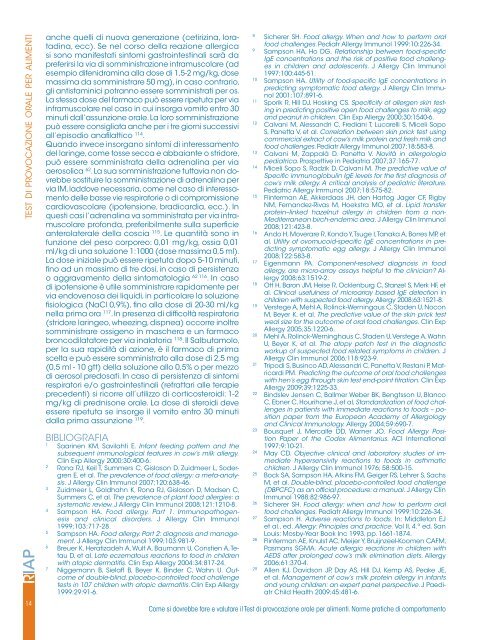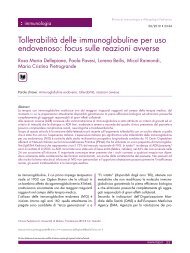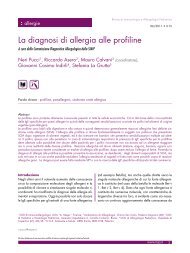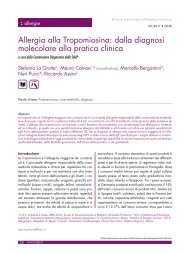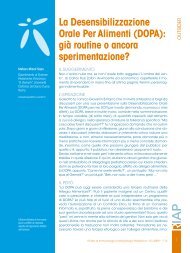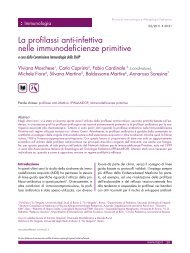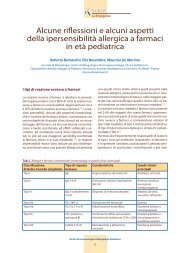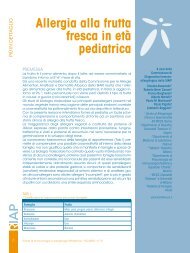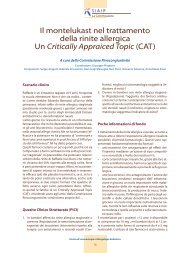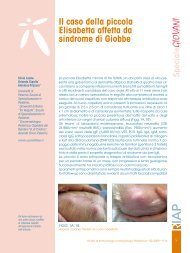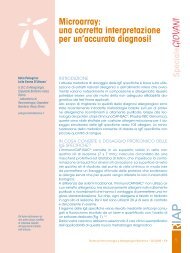Come si dovrebbe fare e valutare il Test di Provocazione ... - RIAP
Come si dovrebbe fare e valutare il Test di Provocazione ... - RIAP
Come si dovrebbe fare e valutare il Test di Provocazione ... - RIAP
You also want an ePaper? Increase the reach of your titles
YUMPU automatically turns print PDFs into web optimized ePapers that Google loves.
TEST DI PROVOCAZIONE ORALE PER ALIMENTI<br />
14<br />
anche quelli <strong>di</strong> nuova generazione (cetirizina, lorata<strong>di</strong>na,<br />
ecc). Se nel corso della reazione allergica<br />
<strong>si</strong> sono manifestati <strong>si</strong>ntomi gastrointestinali sarà da<br />
preferir<strong>si</strong> la via <strong>di</strong> somministrazione intramuscolare (ad<br />
esempio <strong>di</strong>fenidramina alla dose <strong>di</strong> 1,5-2 mg/kg, dose<br />
mas<strong>si</strong>ma da somministrare 50 mg), in caso contrario,<br />
gli antistaminici potranno essere somministrati per os.<br />
La stessa dose del farmaco può essere ripetuta per via<br />
intramuscolare nel caso in cui insorga vomito entro 30<br />
minuti dall’assunzione orale. La loro somministrazione<br />
può essere con<strong>si</strong>gliata anche per i tre giorni succes<strong>si</strong>vi<br />
all’episo<strong>di</strong>o anafi lattico 114 .<br />
Quando invece insorgano <strong>si</strong>ntomi <strong>di</strong> interessamento<br />
del laringe, come tosse secca e abbaiante o stridore,<br />
può essere somministrata della adrenalina per via<br />
aerosolica 62 . La sua somministrazione tuttavia non <strong>dovrebbe</strong><br />
sostituire la somministrazione <strong>di</strong> adrenalina per<br />
via IM, laddove necessaria, come nel caso <strong>di</strong> interessamento<br />
delle basse vie respiratorie o <strong>di</strong> compromis<strong>si</strong>one<br />
car<strong>di</strong>ovascolare (ipoten<strong>si</strong>one, bra<strong>di</strong>car<strong>di</strong>a, ecc.). In<br />
questi ca<strong>si</strong> l’adrenalina va somministrata per via intramuscolare<br />
profonda, preferib<strong>il</strong>mente sulla superfi cie<br />
anterolaterale della coscia 115 . Le quantità sono in<br />
funzione del peso corporeo: 0,01 mg/kg, os<strong>si</strong>a 0,01<br />
ml/kg <strong>di</strong> una soluzione 1:1000 (dose mas<strong>si</strong>ma 0,5 ml).<br />
La dose iniziale può essere ripetuta dopo 5-10 minuti,<br />
fi no ad un mas<strong>si</strong>mo <strong>di</strong> tre do<strong>si</strong>, in caso <strong>di</strong> per<strong>si</strong>stenza<br />
o aggravamento della <strong>si</strong>ntomatologia 62 116 . In caso<br />
<strong>di</strong> ipoten<strong>si</strong>one è ut<strong>il</strong>e somministrare rapidamente per<br />
via endovenosa dei liqui<strong>di</strong>, in particolare la soluzione<br />
fi <strong>si</strong>ologica (NaCl 0,9%), fi no alla dose <strong>di</strong> 20-30 ml/kg<br />
nella prima ora 117 . In presenza <strong>di</strong> <strong>di</strong>ffi coltà respiratoria<br />
(stridore laringeo, wheezing, <strong>di</strong>spnea) occorre inoltre<br />
somministrare os<strong>si</strong>geno in maschera e un farmaco<br />
broncod<strong>il</strong>atatore per via inalatoria 118 . Il Salbutamolo,<br />
per la sua rapi<strong>di</strong>tà <strong>di</strong> azione, è <strong>il</strong> farmaco <strong>di</strong> prima<br />
scelta e può essere somministrato alla dose <strong>di</strong> 2,5 mg<br />
(0,5 ml - 10 gtt) della soluzione allo 0,5% o per mezzo<br />
<strong>di</strong> aerosol predosati. In caso <strong>di</strong> per<strong>si</strong>stenza <strong>di</strong> <strong>si</strong>ntomi<br />
respiratori e/o gastrointestinali (refrattari alle terapie<br />
precedenti) <strong>si</strong> ricorre all’ut<strong>il</strong>izzo <strong>di</strong> corticosteroi<strong>di</strong>: 1-2<br />
mg/kg <strong>di</strong> prednisone orale. La dose <strong>di</strong> steroi<strong>di</strong> deve<br />
essere ripetuta se insorge <strong>il</strong> vomito entro 30 minuti<br />
dalla prima assunzione 119 .<br />
BIBLIOGRAFIA<br />
1 Saarinen KM, Sav<strong>il</strong>ahti E. Infant fee<strong>di</strong>ng pattern and the<br />
subsequent immunological features in cow’s m<strong>il</strong>k allergy.<br />
Clin Exp Allergy 2000;30:400-6.<br />
2 Rona RJ, Ke<strong>il</strong> T, Summers C, Gislason D, Zuidmeer L, Sodergren<br />
E, et al. The prevalence of food allergy: a meta-analy<strong>si</strong>s.<br />
J Allergy Clin Immunol 2007;120:638-46.<br />
3 Zuidmeer L, Goldhahn K, Rona RJ, Gislason D, Madsen C,<br />
Summers C, et al. The prevalence of plant food allergies: a<br />
systematic review. J Allergy Clin Immunol 2008;121:1210-8.<br />
4 Sampson HA. Food allergy. Part 1. Immunopathogene<strong>si</strong>s<br />
and clinical <strong>di</strong>sorders. J Allergy Clin Immunol<br />
1999;103:717-28.<br />
5 Sampson HA. Food allergy. Part 2: <strong>di</strong>agno<strong>si</strong>s and management.<br />
J Allergy Clin Immunol 1999;103:981-9.<br />
6 Breuer K, Heratizadeh A, Wulf A, Baumann U, Constien A, Tetau<br />
D, et al. Late eczematous reactions to food in ch<strong>il</strong>dren<br />
with atopic dermatitis. Clin Exp Allergy 2004:34:817-24.<br />
7 Niggemann B, Sielaff B, Beyer K, Binder C, Wahn U. Outcome<br />
of double-blind, placebo-controlled food challenge<br />
tests in 107 ch<strong>il</strong>dren with atopic dermatitis. Clin Exp Allergy<br />
1999:29:91-6.<br />
8 Sicherer SH. Food allergy. When and how to perform oral<br />
food challenges. Pe<strong>di</strong>atr Allergy Immunol 1999:10:226-34.<br />
9 Sampson HA, Ho DG. Relationship between food-specifi c<br />
IgE concentrations and the risk of po<strong>si</strong>tive food challenges<br />
in ch<strong>il</strong>dren and adolescents. J Allergy Clin Immunol<br />
1997;100:445-51.<br />
10 Sampson HA. Ut<strong>il</strong>ity of food-specifi c IgE concentrations in<br />
pre<strong>di</strong>cting symptomatic food allergy. J Allergy Clin Immunol<br />
2001;107:891-6.<br />
11 Sporik R, H<strong>il</strong>l DJ, Hosking CS. Specifi city of allergen skin testing<br />
in pre<strong>di</strong>cting po<strong>si</strong>tive open food challenges to m<strong>il</strong>k, egg<br />
and peanut in ch<strong>il</strong>dren. Clin Exp Allergy 2000;30:1540-6.<br />
12 Calvani M, Alessandri C, Fre<strong>di</strong>ani T, Lucarelli S, Miceli Sopo<br />
S, Panetta V, et al. Correlation between skin prick test u<strong>si</strong>ng<br />
commercial extract of cow’s m<strong>il</strong>k protein and fresh m<strong>il</strong>k and<br />
food challenges. Pe<strong>di</strong>atr Allergy Immunol 2007;18:583-8.<br />
13 Calvani M, Zappalà D, Panetta V. Novità in allergologia<br />
pe<strong>di</strong>atrica. Prospettive in Pe<strong>di</strong>atria 2007;37:165-77.<br />
14 Miceli Sopo S, Radzik D, Calvani M. The pre<strong>di</strong>ctive value of<br />
Specifi c immunoglobulin IgE levels for the fi rst <strong>di</strong>agno<strong>si</strong>s of<br />
cow’s m<strong>il</strong>k allergy. A critical analy<strong>si</strong>s of pe<strong>di</strong>atric literature.<br />
Pe<strong>di</strong>atric Allergy Immunol 2007;18:575-82.<br />
15 Flinterman AE, Akkerdaas JH, den Hartog Jager CF, Rigby<br />
NM, Fernandez-Rivas M, Hoekstra MO, et al. Lipid transfer<br />
protein–linked hazelnut allergy in ch<strong>il</strong>dren from a non-<br />
Me<strong>di</strong>terranean birch-endemic area. J Allergy Clin Immunol<br />
2008;121:423-8.<br />
16 Ando H, Moverare R, Kondo Y, Tsuge I, Tanaka A, Borres MP, et<br />
al. Ut<strong>il</strong>ity of ovomucoid-specifi c IgE concentrations in pre<strong>di</strong>cting<br />
symptomatic egg allergy. J Allergy Clin Immunol<br />
2008;122:583-8.<br />
17 Eigenmann PA. Component-resolved <strong>di</strong>agno<strong>si</strong>s in food<br />
allergy, are micro-array assays helpful to the clinician? Allergy<br />
2008;63:1519-2.<br />
18 Ott H, Baron JM, Heise R, Ocklenburg C, Stanzel S, Merk HF, et<br />
al. Clinical usefulness of microarray based IgE detection in<br />
ch<strong>il</strong>dren with suspected food allergy. Allergy 2008;63:1521-8.<br />
19 Verstege A, Mehl A, Rolinck-Werningaus C, Staden U, Nocon<br />
M, Beyer K, et al. The pre<strong>di</strong>ctive value of the skin prick test<br />
weal <strong>si</strong>ze for the outcome of oral food challenges. Clin Exp<br />
Allergy 2005;35:1220-6.<br />
20 Mehl A, Rolinck-Werninghaus C, Staden U, Verstege A, Wahn<br />
U, Beyer K, et al. The atopy patch test in the <strong>di</strong>agnostic<br />
workup of suspected food related symptoms in ch<strong>il</strong>dren. J<br />
Allergy Clin Immunol 2006;118:923-9.<br />
21 Tripo<strong>di</strong> S, Bu<strong>si</strong>nco AD, Alessandri C, Panetta V, Restani P, Matricar<strong>di</strong><br />
PM. Pre<strong>di</strong>cting the outcome of oral food challenges<br />
with hen’s egg through skin test end-point titration. Clin Exp<br />
Allergy 2009;39:1225-33.<br />
22 Bindslev Jensen C, Ballmer Weber BK, Bengtsson U, Blanco<br />
C, Ebner C, Hourihane J, et al, Standar<strong>di</strong>zation of food challenges<br />
in patients with imme<strong>di</strong>ate reactions to foods – po<strong>si</strong>tion<br />
paper from the European Academy of Allergology<br />
and Clinical Immunology. Allergy 2004;59:690-7.<br />
23 Bousquet J, Mercalfe DD, Warner JO. Food Allergy Po<strong>si</strong>tion<br />
Paper of the Codex Alimentarius. ACI International<br />
1997;9:10-21.<br />
24 May CD. Objective clinical and laboratory stu<strong>di</strong>es of imme<strong>di</strong>ate<br />
hypersen<strong>si</strong>vity reactions to foods in asthmatic<br />
ch<strong>il</strong>dren. J Allergy Clin Immunol 1976; 58:500-15.<br />
25 Bock SA, Sampson HA, Atkins FM, Geiger RS, Lehrer S, Sachs<br />
M, et al. Double-blind, placebo-controlled food challenge<br />
(DBPCFC) as an offi cial procedure: a manual. J Allergy Clin<br />
Immunol 1988;82:986-97.<br />
26 Sicherer SH. Food allergy: when and how to perform oral<br />
food challenges. Pe<strong>di</strong>atr Allergy Immunol 1999;10:226-34.<br />
27 Sampson H. Adverse reactions to foods. In: Middleton EJ<br />
et al., ed. Allergy: Principles and practice. Vol II, 4.ª ed. San<br />
Louis: Mosby-Year Book Inc 1993, pp. 1661-1874.<br />
28 Flinterman AE, Knulst AC, Meijer Y, Bruijnzeel-Koomen CAFM,<br />
Pasmans SGMA. Acute allergic reactions in ch<strong>il</strong>dren with<br />
AEDS after prolonged cow’s m<strong>il</strong>k elimination <strong>di</strong>ets. Allergy<br />
2006;61:370-4.<br />
29 Allen KJ, Davidson JP, Day AS, H<strong>il</strong>l DJ, Kemp AS, Peake JE,<br />
et al. Management of cow’s m<strong>il</strong>k protein allergy in infants<br />
and young ch<strong>il</strong>dren: an expert panel perspective. J Pae<strong>di</strong>atr<br />
Ch<strong>il</strong>d Health 2009;45:481-6.<br />
<strong>Come</strong> <strong>si</strong> <strong>dovrebbe</strong> <strong>fare</strong> e <strong>valutare</strong> <strong>il</strong> <strong>Test</strong> <strong>di</strong> provocazione orale per alimenti. Norme pratiche <strong>di</strong> comportamento


